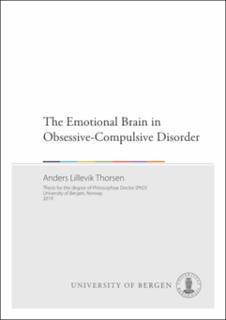| dc.contributor.author | Thorsen, Anders Lillevik | |
| dc.date.accessioned | 2020-02-11T09:42:16Z | |
| dc.date.issued | 2019-11-19 | |
| dc.date.submitted | 2019-10-31T15:23:53.016Z | |
| dc.identifier | container/49/11/3b/d4/49113bd4-246f-44a0-b9a6-e81efeb98aa5 | |
| dc.identifier.isbn | 9788230856246 | |
| dc.identifier.isbn | 9788230859674 | |
| dc.identifier.uri | https://hdl.handle.net/1956/21384 | |
| dc.description.abstract | Background Obsessive-compulsive disorder (OCD) is characterized by distressing obsessions and time-consuming compulsions. The disorder affects 1-3% and can be highly impairing to daily functioning and detrimental to the quality of life. Cognitive behavioral therapy is an effective treatment for 50-75% of people with OCD, leaving a considerable minority who do not benefit from the best available treatments we have today. Neuroimaging has related the disorder to the function and structure of cortico-striato-thalamo-cortical and fronto-limbic circuits. A better understanding of these circuits might contribute to a better understanding of the disorder, how current treatments change the brain, and how we can help non-responders with better treatments in the future. This is likely particularly true for fronto-limbic and affective circuits, given their role in the formation, maintenance, and extinction of fear as well as motivating behavior. The aim of this dissertation was, first, to investigate how OCD is related to brain activation during emotional processing of aversive stimuli. Secondly, we wanted to examine if unaffected siblings of OCD patients showed similar anxiety, brain activation, and connectivity during emotion provocation and regulation as their OCD-affected siblings compared to unrelated healthy controls. Lastly, we wanted to investigate if the resting-state network structure changes in OCD patients directly after the Bergen 4-Day Treatment (B4DT), a concentrated and exposure-based psychological therapy. Methods Paper I was a meta-analysis of 25 functional neuroimaging studies comparing OCD patients and healthy controls during emotion processing, when participants were exposed to aversive or neutral stimuli. In Paper II we used functional magnetic resonance imaging (fMRI) to investigate distress, brain activation, and fronto-limbic connectivity during emotion provocation and regulation of neutral, fear-related, and OCD-related stimuli in 43 unmedicated OCD patients, 19 unaffected siblings, and 38 healthy controls. In Paper III we used resting-state fMRI to study the network structure of 28 OCD patients (21 unmedicated) and 19 healthy controls the day before and three days after B4DT. We examined static and dynamic graph metrics at the global, subnetwork, and regional levels, as well as between-subnetwork connectivity. Results In Paper I, we found that OCD patients showed more activation than healthy controls in the orbitofrontal cortex (OFC), extending into the subgenual anterior cingulate cortex (sgACC) and ventromedial prefrontal cortex (vmPFC), bilateral amygdala (extending into the right putamen), left inferior occipital cortex, and right middle temporal gyrus during aversive versus neutral stimuli. Meta-regressions showed that medication status and comorbidity moderated amygdala, occipital and ventromedial prefrontal cortex hyperactivation, while symptom severity moderated hyperactivation in medial frontal prefrontal and superior parietal regions. In Paper II we showed that unaffected siblings resembled healthy controls in task-related distress, less amygdala activation/altered timing than OCD patients during emotion provocation. During OCD-related emotion regulation siblings showed no significant difference in dmPFC activation versus either OCD patients or healthy controls, but showed more temporo-occipital activation and dmPFC-amygdala connectivity compared to healthy controls. In Paper III we found that unmedicated OCD patients showed more frontoparietal-limbic connectivity before treatment than healthy controls. This, along with sgACC flexibility, was reduced in OCD patients directly after B4DT. Conclusions OCD patients show hyperactivation of the amygdala and related structures, but this characteristic is not directly shared with unaffected siblings during provocation or regulation of emotional information. However, siblings seem to show compensatory activation and connectivity in other areas. The rapid changes in frontoparietal-limbic connectivity and subgenual ACC flexibility suggests that concentrated treatment leads to a more independent and stable network state. OCD is related to subtle alterations in limbic activation and fronto-limbic connectivity during both emotional tasks and resting-state, which seems to vary with comorbidity and is sensitive to treatment. | en_US |
| dc.language.iso | eng | eng |
| dc.publisher | The University of Bergen | eng |
| dc.relation.haspart | Paper I: Thorsen, A. L., Hagland, P., Radua, J., Mataix-Cols, D., Kvale, G., Hansen, B., & van den Heuvel, O. A. (2018). Emotional processing in obsessive-compulsive disorder: A systematic review and meta-analysis of 25 functional neuroimaging studies. Biological Psychiatry: Cognitive Neuroscience and Neuroimaging, 3(6), 563-571. The article is available in the main thesis. The article is also available at: <a href="https://doi.org/10.1016/j.bpsc.2018.01.009" target="blank">https://doi.org/10.1016/j.bpsc.2018.01.009</a>. | eng |
| dc.relation.haspart | Paper II: Thorsen, A. L., de Wit, S. J., de Vries, F. E., Cath, D. C., Veltman, D. J., van der Werf, Y. D., Mataix-Cols, D., Hansen, B., Kvale, G., & van den Heuvel, O. A. (2019). Emotion regulation in obsessive-compulsive disorder, unaffected siblings, and unrelated healthy control participants. Biological Psychiatry: Cognitive Neuroscience and Neuroimaging 4(4), 352-360. The article is available in the main thesis. The article is also available at: <a href="https://doi.org/10.1016/j.bpsc.2018.03.007" target="blank">https://doi.org/10.1016/j.bpsc.2018.03.007</a>. | eng |
| dc.relation.haspart | Paper III: Thorsen, A. L., Vriend, C., de Wit, S. J., Ousdal, O. T., Hagen, K., Hansen, B., Kvale, G., & van den Heuvel, O. A. Effects of Bergen 4-Day Treatment on Resting-State Graph Features in Obsessive-Compulsive Disorder. Biological Psychiatry: Cognitive Neuroscience and Neuroimaging. The article is not available in BORA. The published version is available at: <a href=" https://doi.org/10.1016/j.bpsc.2020.01.007" target="blank"> https://doi.org/10.1016/j.bpsc.2020.01.007</a>. | eng |
| dc.rights | In copyright | eng |
| dc.rights.uri | http://rightsstatements.org/page/InC/1.0/ | eng |
| dc.title | The Emotional Brain in Obsessive-Compulsive Disorder | eng |
| dc.type | Doctoral thesis | |
| dc.date.updated | 2019-10-31T15:23:53.016Z | |
| dc.rights.holder | Copyright the Author. All rights reserved | eng |
| dc.identifier.cristin | 1757179 | |
| fs.unitcode | 17-34-0 | |
